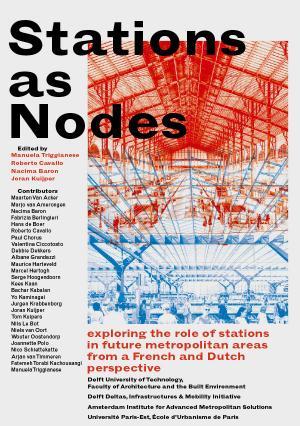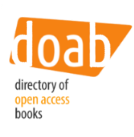Stations as Nodes: exploring the role of stations in future metropolitan areas from a French and Dutch perspective
Keywords:
mobility challenges, railway stations, public transport, smart urban mobility, smart stations, intermodal hubs, spatial integrationSynopsis
At the main point of intersection between the railway and the city, stations are key elements in the organization of the intermodal transport as well as catalysts of urban developments in metropolises, medium and small cities. The focus of this publication is to explore the enrichment of a renewed approach of railway stations as intermodal nodes, therefore acting as breeding grounds for both urban and social developments.
This book has been initiated and built upon several activities currently running at the Amsterdam Institute for Advanced Metropolitan Solutions (AMS Institute), Delft University of Technology (DIMI, Delft Deltas Infrastructure Mobility Initiative and Department of Architecture of the Faculty of Architecture and the Built Environment) and University of Paris-Est (l'École d’Urbanisme de Paris). These activities have been framed within the context of two rapidly developing metropolitan areas: Randstad in the Netherlands and Métropole du Grand Paris in the Ile de France. This volume forms the basis for a research on the 'role of stations in future metropolitan areas' with the ambition to link the two countries, learning from their different cities and distinct geographical context through comparable mobility challenges on the levels of the inner city, suburban and peripheral areas.
In line with these considerations, in 2018 AMS Institute, TU Delft/ DIMI and the Dutch Embassy in Paris with Atelier Néerlandais organized a successful workshop: 'Stations of the Future', in collaboration with La Fabrique de la Cité. Together with Dutch and French planning entities, involving mass transit operators and railway companies, this workshop focused on several case studies in both metropolitan areas to understand the role of station hubs as intermodal nodes. During this joint French-Dutch event that took place in Paris, we spoke on topics like Station as intermodal node, Station as destination and Station as data center, including a debate on the relation between public space and architecture, densification and programming of station areas, pedestrian flows management and the integration of data.
Following the Paris workshop, the summer school 'Integrated Mobility Challenges in Future Metropolitan Areas' was organised by AMS Institute and Delft University of Technology/DIMI with the collaboration of the ARENA architectural research network, University of Paris-Est and the City of Amsterdam. This 8-day workshop extended the debate among international young professionals, academics and master students by looking at an important rail-metro node in the metropolitan area of the city Amsterdam: Sloterdijk Station – a crucial hub in a bigger urban area for mobility and exchange, and for urban growth. The main question was: which approaches and scenarios can be tested and applied to these intermodal nodes, particularly when dealing with lack of space and growing number of users? The results were four very different plans to improve the Sloterdijk Station area and to make the station a 'future proof' intermodal hub.
In this publication, invited experts from practice and knowledge institutes in France and the Netherlands share their common experience and draw on specific aspects and problems of conception, management and development of stations. A brief overview of the results of the two initiatives 'Stations of the Future' and the summer school 'Integrated Mobility Challenges in Future Metropolitan Areas' is here illustrated, accompanied by photo reportages of both events and by a curated reportage of the Amsterdam Sloterdijk station area.
Downloads
References
A. Picon, Smart Cities (2013). 4 S. Allemand et al., Le sens du mouvement (2004).
Augé, M. (1992). Non-lieux : introduction à une anthropologie de la sur-modernité (Seuil). Paris.
B. Kabalan et al., 'A Crowd Movement Model for Pedestrian Flow through Bottlenecks', Annals of Solid and Structural Mechanics, 2016. https://doi.org/10.1007/s12356-016-0044-3
B. Kabalan et al., 'Framework for Centralized and Dynamic Pedestrian Management in Railway Stations', EWGT, 2017.https://doi.org/10.1016/j.trpro.2017.12.091
Bektas, T., Crainuc, T.G. (2007), 'A Brief Overview of Intermodal Transportation', January 2017, CIRRELT-2017-02, University of Montreal
Bertolini, L. (1999). Spatial development patterns and public transport: e application of an analytical model in the Netherlands. Planning Practice and Research, 14(2):199 -210 https://doi.org/10.1080/02697459915724
Best, K., & Hindmarsh, J. (2018). Embodied spatial practices and everyday organization: The work of tour guides and their audiences. Human Relations, 3. https://doi.org/10.1177/0018726718769712
Best, K., & Hindmarsh, J. (2018). Embodied spatial practices and everyday organization: The work of tour guides and their audiences. Human Relations, 4. https://doi.org/10.1177/0018726718769712
Beyes, T., & Steyaert, C. (2012). Spacing organiza-tion: non-representational theory and performing organizational space. Organization, 19(1), 45 - 61. https://doi.org/10.1177/1350508411401946
Business Insider, 11 May 2017, http://uk.businessin-sider.com/apple-car-au-tonomous-driving-2017-5. Accessed 14 August 2018.
C. van Eesteren and Th. K. van Lohuizen. Algemeen Uitbreidingsplan Amsterdam, 1934. Collectie NAi
College van Burgemeester en Wethouders (2010, 26 January) Ontwerp Structuurvisie Amsterdam 2040, Economisch Sterk en Duurzaam. Amsterdam: Gemeente Amsterdam, pp9-12.
Costas, J. (2013). Problematizing Mobility: Metaphor of Stickiness, Non-Places and the Kinetic Elite. Organizational Studies 34(10), 1468. https://doi.org/10.1177/0170840613495324
Costas, J. (2013). Problematizing Mobility:Metaphor of Stickiness, Non-Places and the Kinetic Elite. Organization Studies 34(10), 1467-1485. https://doi.org/10.1177/0170840613495324
Davoudi, Simin (2009) Planning and Interdisciplinarity [paper presented at the AESOP Heads of School Seminar]
De Echo (2017, 5 July) Tuin van Bret bedoeld als Voorbeeldproject, We willen laten zien dat het Anders kan. In: De Echo - Amsterdam West, Woensdag 5 Juli 2017
F. Ascher, L'âge des métapoles (2009).
Günter Kolb, Otto Wagner und die Wiener Stadtbahn, Munich (Scaneg) 1989.
Hagberg, J., & Styhre, A. (2013). The production of social space : shopping malls as relational and transductive spaces. Journal of Engineering, Design and Technology, 11(3), 354-374. https://doi.org/10.1108/JEDT-04-2011-0019
Hass-Klau, C. et al., (2000), 'Bus or Light Rail: Mak-ing the Right Choice. A Financial, Operational and Demand Comparison of Light Rail, Guided Buses, Busways and Bus Lanes', Environmental and Transport Planning, Brighton
Hass-Klau, C., G. Cramp-ton and R. Benjari (2004), 'Economic Impact of Light Rail: The Results of 15 Urban Areas in France, Germany, UK and North America', Environmental and Transport Planning, Brighton
I. Joseph, 'Gares intelligentes, accessibilité urbaine et relais de la ville dense', RATP-Mission Prospective 1999.
Jones W.B., C.R. Cassady and R.O. Bowden (2000), De-veloping a Standard Definition of Intermodal, dissertation of MSc programme of Planning, Organization and Management of Transport Systems of Aristotle University of Thessaloniki, Greece
Knox, H., O'Doherty, D., Vurdubakis, T., & Westrup, C. (2008). Enacting Airports: Space, Movement and Modes of Ordering. Organization, 15(6), 869-888. https://doi.org/10.1177/1350508408095818
Küpers, W. (2015). De- + -Touring through Embodied ' Inter-Place .' Touring Consumption, (Springer Fachmedien Wiesbaden), 133-160. https://doi.org/10.1007/978-3-658-10019-3_7
Le Monde, 10 May 2017, http://www.lemonde.fr/economie/article/2017/05/10/citymapper-teste-une-ligne-de-bus-a-londres_5125436_3234.html. Accessed 14 August 2018.
Le Monde, 23 September 2016, http://www.lemonde.fr/economie/article/2016/09/23/un-minibus-sans-conduc-teur-en-demonstration-a-paris_5002697_3234.html. Accessed 14 August 2018.
Lee, A., N. van Oort and R. van Nes (2014), 'Service Reliability in a Network Context', Transportation Research Record, vol. 2417, 18-26 https://doi.org/10.3141/2417-03
Lefebvre, H. (1992). Eléments de rythmanalyse : introduction à la connaissance des rythmes. Editions Syllepse.
M. Castells, The Rise of the Network Society (2009). https://doi.org/10.1002/9781444319514
Manders, Ton en Clemens Kool (2015) Toekomstverkenning, Welvaart en Leefomgeving, Nederland in 2030 en 2050: Twee referentiescenario's. Den Haag: Centraal Planbureau/Planbureau voor de Leefomgeving, p. 30
Metz, Tracy (2015, 21 April) Met Ongeduldige Burgers krijg je Vanzelf een Doe-Het-Zelf-Stad. In: Het Parool, 21 april 2015, magazine PS van de Week, pp. PS4-PS5
Monzón, A., S. Hernández and F. Di Ciommo (2016), Efficient Urban interchanges: The City-HUB Model', Transp. Res. Proc. 14 (Elsevier), 1124 -1133 https://doi.org/10.1016/j.trpro.2016.05.183
N. Molyneaux, R. Scarinci and M. Bierlaire, 'Pedestrian Management Strategies for Improving Flow Dynamics in Transportation Hubs', 17th Swiss Transport Research Conference, 17-19 May 2017.
O'Doherty, D. P. (2016). Reconstructing organization: The loungification of society. Reconstructing Organization: The Loungification of Society, (Augé), 1- 324. https://doi.org/10.1057/978-1-137-48922-7_1
Otto Wagner, Moderne Architektur, Seinen Schülern ein Führer auf diesem kunstgebiete, Vienna 1896, 1898, 1902, revisited in 1914.
Pallasmaa, J. (2014). Space, place and atmosphere. Emotion and peripheral perception in architectural experience. Lebenswelt. Aesthetics and Philosophy of Experience., 1934(4), 23 0 - 245.
Patrick Ropert. City Booster: Les gares à l'aube d'une révolution (2017) éditions Débats Publics
Pitsiava-Latinopoulou, M. and P. Iordanopoulos (2012), 'Intermodal Passengers Terminals: Design Standards for Better Level of Service', Procedia - Social and Behavioral Sciences, Transport Research Arena 48, 3297-3306 https://doi.org/10.1016/j.sbspro.2012.06.1295
Programmabureau Haven-Stad (2017, 20 June) Haven-Stad, Transformatie van 12 Deelgebieden, Concept Ontwikkelstrategie. Amsterdam: Gemeente Amsterdam / Directie Ruimte en Duurzaamheid, pp, 13 and 17
Provincie Noord-Holland & Vereniging Deltametropool (2013) Maak Plaats! Werken aan knooppuntontwikkeling in Noord-Holland (Make Space! Working towards TOD in Noord-Holland), Provincie Noord-Holland
R. Knafou, 'Mobilités touristiques et de loisirs et système global des mobilités', in: Bonnet and Desjeux (eds.), Les territoires de la mobilité (2000). https://doi.org/10.3917/puf.bonne.2000.01.0085
Reckwitz, A. (2002). Toward a Theory of Social Practices. A Development in Culturalist Theorizing. European Journal of Social Theory, 5(2), 243 -263. https://doi.org/10.1177/13684310222225432
Scheffer, Paul (2004, 25 June) Terug naar de Tuinstad, Segregatie en Integratie in Amsterdam. (inaugural speech) Amsterdam: Vossiuspers UvA
Scott, M., Ch. Kelly and E. Collins (2013), Intermodal Transportation Facilities: Research of Viable Attributes and Potential to Integrate Curbside Intercity Buses, prepared by Institute for Public Administration School of Public Policy & Administration College of Arts & Sciences University of Delaware
Serper, E.Z. and S.A. Alumur (2016), 'The Design of Capacitated Intermodal Hub Networks with Different Vehicle Types', Transportation Research Part B Methodological 86, 51- 65https://doi.org/10.1016/j.trb.2016.01.011
Shortt, H. (2015). Liminality, space and the importance of 'transitory dwelling places' at work. Human Relations, 68(4), 6 3 3 - 6 5 8. https://doi.org/10.1177/0018726714536938
SNCF, Open data: https://ressources.data.sncf.com/explore/dataset/frequen-tation-gares/?q=Biblio-th%C3%8que&sort=nom_gare. Accessed on 20 July 2017.
Studio Secchi Vigano', Habiter le Grand Paris, Study realised for the Atelier International du Grand Paris, Oct. 2013.
Süddeutsche Zeitung, 28 November 2016, http://www.sueddeutsche.de/digital/ransomware-wannacry-die-letzte-warnung-1.3504595. Accessed 14 August 2018.
The Guardian, 28 Novem-ber 2016, https://www.theguardian.com/technol-ogy/2016/nov/28/passen-gers-free-ride-san-fran-cisco-muni-ransomeware. Accessed 14 August 2018.
Triggianese, M. Euralille twenty years on. OverHolland, [16/17], p. 111-139, mar. 2017.
Turner, V. (1983). Liminal to Liminoid, in Play, Flow, and Ritual: An Essay in Comparative Symbology. Rice Institute Pamphlet-Rice University Studies, 60(3), 123 -164.
UIC Handbook on Railway Stations Adapting to Future Society (2013) Available online: https://uic.org
UIC Handbook on Smart Stations in Smart Cities (2017) Available online: https://uic.org
Vaaland, M. (2010). What we Talk about when we Talk about Space : End User Participation between Processes of Organizational and Architectural Design. Copenhagen Business School.
Van Eesteren, Cornelis (1928, as published in 1997) Het Idee van de Functionele Stad: Een Lezing met Lichtbeelden 1928. Distributed Art Pub Incorporated, p.23
Van Hagen, M. and N. van Oort (2018), 'Improving Railway Passengers Experience: Two Perspectives', CASPT conference, Brisbane
Van Oort, N., R.A.J. v.d. Bijl and F.C.A. Verhoof (2017), 'The Wider Benefits of High Quality Public Transport for Cities', European Transport Conference, Barcelona
Venturini, Tommaso, Pablo Jensen, and Bruno Latour (2015). Fill in the Gap, A New Alliance for Social and Natural Sciences. In: Journal of Artificial Societies and Social Simulation, SimSoc Consortium, 2015, 18 (2), pp. 18-29. https://doi.org/10.18564/jasss.2729
Weinfurtner, T., & Seidl, D. (2018). Towards a spatial perspective: An integrative review of research on organisational space. Scandinavian Journal of Management, (April 2017), 1- 30.
Weinfurtner, T., & Seidl, D. (2018). Towards a spatial perspective: An integrative review of research on organisational space. Scandinavian Journal of Management, (April 2017), p 4.





